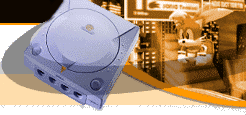| |
Dead or Alive 2
It's... it's... ALIVE! - Review By Fragmaster
 Soul Calibur kicks ass. That's an undisputable fact. Without the presence of Soul Calibur in the Dreamcast software library, the system wouldn't be nearly as successful. Soul Calibur kicks ass. That's an undisputable fact. Without the presence of Soul Calibur in the Dreamcast software library, the system wouldn't be nearly as successful.
It may be hard to believe, but Soul Calibur was released over six months ago now. All this time, the only fighting game on the horizon that looked like it might have a chance to dethrone Namco's nearly-perfect weapons fighter has been Tecmo's Dead or Alive 2. Not an easy challenge.
Finally, after a one month delay, Dead or Alive 2 is here. The story behind the game goes like this: at the end of the 20th century, some famous leader named Fame Douglas was murdered. He was the sponsor of the first Dead or Alive World Combat Championship, and after his death chaos ensued due to the lack of a powerful leader. So during all of this strife, the evil guy who killed Douglas decides to start a second Dead or Alive tournament. And his involvement causes some big disaster to happen or something.. The story really doesn't matter, have an effect on the game, or even make much sense. So let's cut to the chase. The big question is: does DoA2 live up to all the hype?
The Good
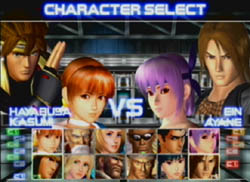
DoA 2 features a cast of twelve characters, some new, some familar. |
First of all, it's inevitable that DoA2 will be compared to Soul Calibur. In fact, I've already compared the two in the introduction of this review. Is that really fair? No, especially considering that the two games share many differences - most notably the fact that DoA2 is a traditional fists and feet brawler, while Soul Calibur is weapons-based. But, everyone's gonna do it anyway, since they're both 3D fighters that share enough similarities to make them worth comparing.
The graphics? You've seen the screenshots. They rock pretty hard. The game has a different "look" than Soul Calibur, so it's hard to say which one looks better, but as it stands DoA2 is a beautiful game. Of course you're probably familiar with how good the characters look, since Tecmo and Team Ninja hasn't exactly been shying away from giving the female cast of combatants a lot of... ermmm... exposure. Like the original DoA, much attention has been directed to the rendering of the female characters' upper chest area (there, I said it in a nice way). Apparently, none of the women of DoA2 believe in bras, and the modelers must have spent a lot of time studying the physics. That's all I'm going to say about that, except for the fact that the "sexy animations" (as Team Ninja calls them) are much more subtle and realistic than they were in the previous game.
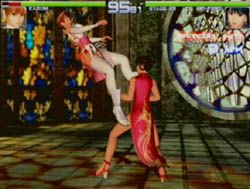
See that window to the right? You can actually throw other players through it and into the courtyard below. And then you can duke it out in the courtyard. Cool. |
Oh, and believe it or not, there are more to graphics than just good-looking breasts. In fact, there are even some male characters in the game! How quaint! Seriously though, the characters are really well-modeled, detailed, animated, and designed. You can even knock the accessories off a couple of the characters if you hit them hard enough. There are twelve playable characters in all, and each has at least two costumes to strut their stuff in. Kasumi and Lei-Fang have four, and Hayabusa, Zack, Jann-Lee, and Ayane have three.
The environments look great too. There are nine stages in all, and while all do not feature multiple levels of fighting, they all look great. The reflections on the floors are especially nice. The Cathedral Tower, City Rooftops, Opera House, and Japanese Garden levels are the best of the bunch. In the exquisitely lovely Cathedral, you can throw an opponent through the stained glass of the tower and into the courtyard below, jump down, and keep on fighting. Nifty. In the Japanese Garden, you'll have to deal with terrain changes and a waterfall. Sweet.

Everybody's a winner when breasts are involved. I guess. |
On to the gameplay. If you're used to playing Soul Calibur all day, DoA2 will feel incredibly weird at first. The style of gameplay is very different, due to the lack of weapons, obviously, but also because of an almost completely different fighting system and style of fighting. DoA2 is much more easily compared to Virtua Fighter than Soul Calibur. The four basic moves are punch (X), kick (Y), "free" (A), and throw (B). Also unusual is the fact that the analog stick is used for free stepping (moving around in 3D). Note that you can also free step by using a "free" button and D-Pad combination, or holding down the triggers. The free button is also used for holding and countering, among other things. Unlike Soul Calibur, blocking is handled Street Fighter/Tekken style, by pressing the D-Pad back.
Winning in DoA2 is all about successful countering, holds, and stringing short combos together. The characters in DoA2 don't have nearly as many moves as their counterparts in Soul Calibur, but it's easier to string them together to create your own super combos. There's also the addition of tag-style gameplay, which changes things quite a bit too. More on that later. Holds are hard to master, but once you get it right you can pull off a variety of counters. For example, you can stop a kick by grabbing the dude's leg, spinning him around, and hitting him in the back while he staggers. Very cool. You won't get very far against skilled players if you just keep mashing the punch and kick buttons, executing endless combos, because they'll make you pay with counter holds.
And another great thing about DoA2's gameplay is that the environment plays a big factor. In Soul Calibur, there were just ring outs, but here, there's much more. You can throw people against walls, kick them into electrically charged conduits, or toss them off ledges onto a lower level. Clever use of the environment can mean the difference between winning and losing, but don't start thinking that using the levels to your advantage is essential, because it's not. For example, you probably won't win if you spend all your time trying to hit people against an electrical fence.
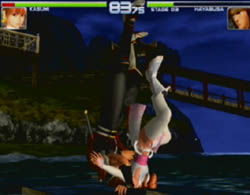
A spinning piledriver into the ground? That probably stings. |
So DoA 2's battle system has plenty of depth, and you'll have to invest a lot of time to properly master all its intricacies. Is it as deep as Soul Calibur? Virtua Fighter? In some ways it is, in others it isn't. But the point is that this isn't one of those games where you can learn one combo, beat the crap out of anybody, and not have to do anything else. There's much more to this game than that. I can see people playing DoA2 against each other for months to come, continually improving their game.
There are several different gameplay modes: Story, Time Attack, Survival, Tag Battle, Team Battle, Sparring, and Versus. Story is the main single player gameplay mode, where you pick a character and fight through the game in traditional arcade fashion. Each match is sandwiched by short cinematics that set up the end encounters. Some attempt to explain why the two people are fighting and others just give the opponents a chance to trash talk each other. You fight about seven different matches before fighting Evil Tengu, the final boss. I don't want to give anything away, but Evil Tengu is one of the weirdest bosses I've ever seen, and he usually manages to put up a decent challenge. In Time Attack mode, you play eight matches, and once you're done the game displays your total time and average time per match. Obviously, you play for high score. Nothing special. Survival mode in DoA2 is a bit more complicated than the survival modes in other fighting games. It still involves facing off against computer opponents until you run out of health, which is partially restored after each fight, but DoA2 adds items which award points and occasionally restore your health. You can also set off "danger reach" by setting off explosions and earning a certain amount of points. During danger reach, you earn double the points you normally would. Not dramatically different than typical Survival modes, but worth mentioning. Versus is just what you'd expect, pitting two human players against each other. Team Battle mode is pretty much the same, except you choose teams of up to five fighters and play against another human or CPU player, tournament style. Sparring is practice mode.. not much more needs to be said.
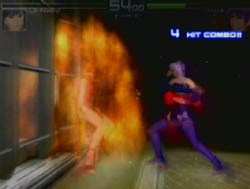
Getting punched into an exploding wall hurts. |
And then there's Tag Battle. If you're familiar with Tekken Tag Tournament, you know what I'm talking about, but in case you don't, you basically pick two characters and have the ability to switch characters at almost any time in the match. While a character is "sitting out," they regain health, so you need to balance the use of each fighter. You can start combos with one character and end them with another, switching back and forth constantly to dish out the pain. There are even tag combos you can only do with a specific combination of characters.
Where DoA2 really shines is four-player Tag Battle. This rules. There's nothing better than getting three other people in front of the Dreamcast, tagging in and out to apply the smack on each other. It really is a different gameplay experience, especially once you figure out the tag combos. Working together as a team is not only crucial to winning, but it's fun as hell.
As for single player, the AI puts up a good fight, even on default difficulty. It's especially brutal in Tag Battle, where you'll probably have a little trouble beating the computer. Even on the default skill, you'll have trouble in some of the later matches due to the AI's dexterity and ability to switch players at exactly the right times. In case the game doesn't suit you, there are also plenty of options. You can adjust difficulty, life gauges, round time, and match point (number of rounds you need to fight to win) for any of the different gameplay modes.
DoA 2 delivers sonically too, with great sounds and some pretty cool music. Nothing particularly special or unusual, but they more than do the job.
The Bad
Despite the outstanding graphics, there are a few glitches. For one, the clipping / bounding boxes could be a little better. This is especially apparent when players of differing size are matched against each other. Body parts will clip right through each other, disappearing. It really isn't that bad, and doesn't take away from the gameplay, but it is more noticeable than it should be.
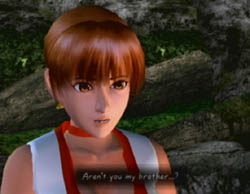
The cinematics between fights in story mode look nice, but don't accomplish much. Here Kasumi finds her brother, but then procedes to fight him like her worst enemy anyway. Huh? |
As a single player game, DoA2 doesn't have too much going for it. Story mode is very unrewarding and not very compelling. The cinematics between levels are nice to look at, but once you've seen them once, you don't need to see them again. The endings are even worse than Soul Calibur's. There's like one screen and maybe one line of bad text, and then the credits roll. Nothing is resolved (was there anything to resolve?). Tag Battle mode in single player just ends with "GAME OVER." It won't take you long to beat the game in Story mode, even if you solve it with all twelve different players. And there's really no incentive to do so, since you won't unlock any new characters or get new goodies. Tecmo really should have added some features that would make the game more appealing to those people who don't have friends to play against all the time.
The gameplay isn't perfect, as there are a couple of quirks. It's not as easy to evade or back away from moves as it is in Soul Calibur, for example. This would be a useful feature to have since the game has a slightly more defensive slant, and as it is it's rather hard to retreat.

Tag Battle rocks. Here you see Ayane about to jump in to give her partner Ein a break. This isn't the WWF, so you can't both beat on one character at once, but you can pull off mad combos together as you're switching off. |
Some of the environments are a little mundane and boring, lacking multiple levels of fighting or amazing interactive features. The fact you can only Tag Battle in one (not particularly interesting) arena is especially distressing.
The interface is inconsistent and quirky, lacking some features that are usually assumed to be standard in a game of this type. For example, if you pause in the middle of a match, you'd assume there'd be a menu that would pop up to let you quit and return back to the main menu. Instead, it just pauses the game. If you want to get back to the main menu, you have to do a soft reset by holding down all four buttons and pressing start. Lame. Also, while it's easy to replay a versus match, since at the end of the match you can choose to play the match again, select new characters, or exit, you can't do the same in Team Battle mode. In fact, after one team wins in Tag Battle, the winning team goes on to play against the computer, and the losing team has to press start to get back in. Huh?
This is a really minor nitpick, but for the miniscule amount of text in the game, it really isn't translated that well. Like Soul Calibur, the game uses Japanese voice acting with English subtitles, but some of the subtitled translations don't make much sense. A few examples include "A winner is me!" (it reminds me of "A winner is you!" from the old NES Pro Wrestling), "Everything is my!," and "Good vibration!" Ahem.
The Final Word
Is Dead or Alive 2 the best fighting game on the Dreamcast? It depends on your own personal preference. Personally, I think Soul Calibur's crown is safe and sound. Is it one of the best fighting games on the Dreamcast? Definitely. And that's saying a lot, since the system has plenty of fighters to choose from. If you like Soul Calibur and/or Virtua Fighter 3TB, but are ready for something different, give DoA 2 a try.
Developer: Team Ninja (Tecmo)
Publisher: Tecmo
Genre: Fighting
Highs: Great graphics, gameplay, sound, and style. Four-player Tag Battle rocks.
Lows: Minor graphical quirks, gameplay issues. Lack of single player appeal and poor interface.
Other: 1-4 players, VMU Compatible (7 blocks), Jump Pack Compatible, Arcade Stick Compatible.
|
Final Score:

(out of a possible 10)
|
Visit this Game's Dreamcast Database Entry
Previous Reviews
Comments on this review? Mail Feedback.
|

